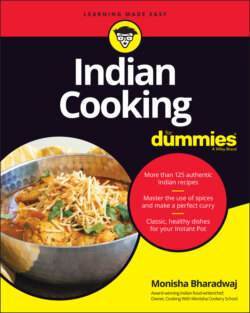Читать книгу Indian Cooking For Dummies - Monisha Bharadwaj - Страница 64
Flavorings
ОглавлениеSalt is a very important ingredient in the Indian kitchen, and your food just won’t taste right without it. It won’t taste good without sour ingredients either. You’ve probably tasted tamarind already (just check the ingredient list on your bottle of Worcestershire sauce) or in Asian and Mexican foods. Sweet tamarind is different from the sour pods needed in Indian curries.
Table 4-3 lists the flavorings you should have on hand.
TABLE 4-3 Buying Flavorings
| Flavoring | Description |
|---|---|
| Salt | Choose fine sea salt if you want additive-free or you can use regular table salt. |
| Sugar | Granulated sugar is used for sweets or to balance flavors in a curry without changing its color. |
| Jaggery | Jaggery is a block of cooked sugarcane juice. It’s used in some Indian desserts and curries to add an earthy sweetness. The block can be grated or cut. Jaggery melts like sugar when heated. It can be stored in an airtight box for up to a year. Brown sugar can be used as a substitute for jaggery. |
| Tamarind | The sausage-shaped fruit of a large tree, tamarind is sold in blocks that can be stored for up to a year. Look for wet tamarind, which feels softer than hard blocks. It’s rehydrated in hot water (see Chapter 6). Tamarind concentrate can be too intense and can change the color of the final dish, so avoid it. Jars of ready-made paste are available, but they’re more expensive than buying the blocks and making the paste yourself. |
| Vinegar | White or brown vinegar is used in some Indian curries to add a sour note. Specially flavored vinegars aren’t essential because the subtle notes will be lost among the stronger-smelling spices. |
